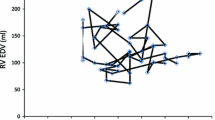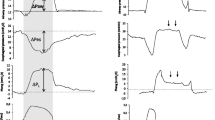Abstract
Spontaneous inspiration causes an increase in right ventricular stroke volume due to a transient increase in venous return. In contrast, spontaneous inspiration causes a fall in left ventricular stroke volume which is exaggerated in conditions of accentuated pleural pressure swings and pericardial disease. This is manifested by the clinical sign ofpulsus paradoxus. Recent evidence supports the idea thatpulsus paradoxus is the result of two mechanisms. First, negative pleural pressure surrounding the left ventricle is equivalent to an increase in aortic pressure and impedes emptying of the left ventricle much like an increase in afterload. Second, distention of the right ventricle due to the transient increase in venous return causes an elevation of left ventricular diastolic pressure due to ventricular interdependence and therefore impedes left ventricular filling. The mechanism of negative pleural pressure “afterload” is thought to be the major cause of pulsus paradoxus when pleural pressure swings are accentuated. Ventricular interdependence is thought to predominate when pericardial disease is present.
Similar content being viewed by others
References
Angelone A, Coulter NA Jr (1965) Heart rate response to held lung volume. J Appl Physiol 20:464–468
Anrep GV, Pascual W, Rossler R (1936) Respiratory variations in heart rate. I. The reflex mechanism of respiratory arrhythmia. Proc R Soc (Lond) B 119:191–217
Bemis CE, Serur Jr, Borkenhagen D, Sonnenblick EH, Urschel CW (1974) Influence of right ventricular pressure and dimension. Circ Res 34:498–504
Bishop VS, Stone HL, Horwitz LD (1971) Effects of tachycardia and ventricular filling pressure on stroke volume in the conscious dog. Am J Physiol 220:436–439
Brecher GA, Mixter G Jr, Share L (1962) Dynamics of venous collapse in superior vena cava system. Am J Physiol 171:194–203
Brecher GA, Mixter G Jr (1953) Effect of respiratory movements on superior cava flow under normal and abnormal conditions. Am J Physiol 172:457–461
Brecher GA, Hubay CA (1965) Pulmonary blood flow and venous return during spontaneous respiration. Circ Res 3:210–214
Brecher GA (1956) Venous return. Grune & Stratton, New York
Brinker JA, Weiss JL, Lappe DC, Rabson JL, Summer WR, Permutt S, Weisfeldt ML (1980) Leftward septal displacement during right ventricular loading in man. Circulation 61:626–633
Buda A, Pinsky MR, Jugels NB, Daughters GT, Stinson EB, Alderman EL (1979) Effect of intrathoracic pressure on left ventricular performance. N Engl J Med 301:453–459
Caldini P, Permutt A, Waddell JA, Riley RL (1974) Effect of epinephrine on pressure, flow and volume relationships in the systemic circulation of dogs. Circ Res 34:606–623
Cassidy SS, Eschenbacher WL, Johnson RL (1979) Reflex cardiovascular depression during unilateral lung hyperinflation in the dog. J Clin Invest 64:620–626
Daly M de B, Hazzledine JL, Ungar A (1967) The reflex effect of alterations in lung volume on systemic vascular resistance in the dog. J Physiol (Lond) 188:331–351
Davies CT, Neilson JM (1967) Sinus arrhythmia in man at rest. J Appl Physiol 22:947
Dock W (1961) Inspiratory traction on the pericardium. The cause of pulsus paradoxus in pericardial disease. Arch Intern Med 108:837–840
Dornhorst AC, Howard P, Leathart GL (1952) Pulsus paradoxus. Lancet 1:746–748
Elzinga G, Van Grondelle R, Westerhof N, Van den Bos GC (1974) Ventricular interference. Am J Physiol 226:941–947
Franklin DL, Van Citters RL, Rushmer RF (1962) Balance between right and left ventricular output. Circ Res 10:17–26
Freychuss U, Melcher A (1976) Respiratory sinus arrhythmia in man: relation to cardiovascular pressures. Scand J Clin Lab Invest 36:321–329
Gabe II, Gault JH, Ross J Jr, Mason DT, Mills CJ, Schillingford JP Braunwald E (1969) Measurement of instantaneous blood flow velocity and pressure in conscious man with a catheter-tip velocity probe. Circulation 40:603–614
Gauchat HW, Katz LN (1924) Observations on pulsus paradoxus (with special reference to pericardial effusions). Arch Intern Med 33:350–370
Glantz SA, Wisbach GA, Moores WY, Mathey DG, Leleven J, Stowe DF, Parmley WW, Tyberg JV (1978) The pericardium substantially affects the left ventricular diastolic pressure-volume relationship in the dog. Circ Res 42:533–541
Glick G, Wechsler AS, Epstein SE (1969) Reflex cardiovascular depression produced by stimulation of pulmonary stretch receptors in the dog. J Clin Invest 48:467–473
Goldblatt A, Harrison DC, Glick G, Braunwald E (1963) Studies on cardiac dimension in intact, unanesthetized man. II. Effects of respiration. Circ Res 13:455–460
Golinko RJ, Kaplan N, Rudolph AM (1963) The mechanism of pulsus paradoxus during acute pericardial tamponade. J Clin Invest 42:249–257
Guntheroth WG, Morgan BC, Mullins GL (1967) Effect of respiration on venous return and stroke volume in cardiac tamponade. Mechanism of pulsus paradoxus. Circ Res 20:381–390
Guyton AC, Adkins LH (1954) Quantitative aspects of the collapse factor in relation to venous return. Am J Physiol 177:523–527
Guyton AC, Polizo D, Armstrong GG Jr (1954) Mean circulatory filling pressure measured immediately after cessation of heart pumping. Am J Physiol 179:261–267
Guyton AC, Armstrong GG Jr, Chipley PL (1956) Pressure-volume curves of the entire arterial and venous systems in the living animal. Am J Physiol 184:253–258
Guyton AC, Jones CE, Coleman TG (1973) Circulatory physiology: Cardiac output and its regulation. Saunders WB, Philadelphia
Guyton AC (1976) Textbook of medical physiology, 5th edn Saunders, Philadelphia, p 242
Hales S (1941) Statical essays: Containing haemastatics. In: Willius FA, Keys TE (eds) Cardiac classics, Mosby, CV, St. Louis, pp 131–147
Hoffman JIE, Guz A, Charlier AA, Wilcken DEL (1965) Stroke volume in conscious dogs: effect of respiration, posture and vascular occlusion. J Appl Physiol 20:865–877
Holt JP (1941) The collapse factor in the measurement of venous pressure. Am J Physiol 134:292–299
Holt JP (1944) The effect of positive and negative intrathoracic pressure on cardiac output and venous pressure in the dog. Am J Physiol 142:594–603
Howell JBL, Permutt S, Proctor DF, Riley RL (1961) Effect of inflation of the lung on different parts of pulmonary vascular bed. J Appl Physiol 16:71–76
Hull E (1967) In: Sodeman WA (ed) Pathologic physiology: Mechanisms of disease, 4th edn. Saunders WB, Philadelphia, p 433
Katz LN, Gauchat HW (1924) Observations on pulsus paradoxus (with special reference to pericardial effusions), II. Exp Arch Intern Med 33:371–393
Kelly DT, Spotnitz HM, Beiser GD, Pierce JE, Epstein SE (1971) Effects of chronic right ventricular volume and pressure loading on left ventricular performance. Circulation 44:403–412
Knowles GK, Clark TJH (1973) Pulsus paradoxus as a valuable sign indicating severity of asthma. Lancet 2:1356–1359
Kussmaul A (1873) Ueber Schwielige Mediastino — Pericarditis und den Paradoxen Puls. Klin Wochenschr 10:433
Maloney JE, Bergel DH, Glazier JB, Hughes JMB, West JB (1968) Transmission of pulsatile blood pressure and flow through the isolated lung. Circ Res 23:11–24
Masumi RA, Mason DT, Zakauddin V, Zelis R, Otero J, Amsterdam EA (1973) Reversed pulsus paradoxus. N Engl J Med 289:1272–1275
Morgan BC, Guntheroth WG, Dillard DH (1965) Relationship of pericardial to pleural pressure during quiet respiration and cardiac tamponade. Circ Res 16:493–498
Morgan BC, Abel FL, Mullins GL, Guntheroth WG (1966) Flow patterns in cavae, pulmonary artery, pulmonary vein, and aorta in intact dogs. Am J Physiol 21:903–909
Morgan BC, Dillard DH, Guntheroth WG (1966) Effect of cardiac and respiratory cycle on pulmonary vein flow, pressure and diameter. J Appl Physiol 21:1276–1280
Morkin E, Collins JA, Goldman HS, Fishman A (1965) Pattern of blood flow in pulmonary veins of the dogs. J Appl Physiol 20:1118–1128
Moulopoulos SD, Sarcas A, Stramatelopoulos S, Arealis E (1965) Left ventricular performance during by-pass or distension of the right ventricle. Circ Res 17:484–491
Ott NT, Shepherd JT (1971) Vasodepressor reflex from lung inflation in the rabbit. Am J Physiol 221:889–895
Parsons GH, Green JF (1978) Mechanisms of pulsus paradoxus in upper airway obstruction. J Appl Physiol Respir Environ Exer Physiol 45:598–603
Permutt S, Howell JBL, Proctor DF, Riley RL (1961) Effect of lung inflation on static pressure-volume characteristics of pulmonary vessels. J Appl Physiol 16:64–70
Permutt S, Bromberger-Barnea B, Bane HN (1962) Alveolar pressure, pulmonary venous pressure and the vascular waterfall. Med Thorac 19:239–260
Permutt S, Caldini P (1978) Regulation of cardiac output by the circuit: venous return. In: Baan J, Noordergraff A, Raines J (eds) Cardiovascular system dynamics. The MIT Press, Cambridge MA, pp 465–479
Pillerson AL (1967) Pulse-wave propagation through the pulmonary vascular bed of dogs. Am J Physiol 213:450–454
Rebuck AS, Read J (1971) Assessment and management of severe asthma. Am J Med 51:788
Rebuck AS, Pengelly LD (1973) Development of pulsus paradoxus in the presence of airways obstruction. N Engl J Med 288:66
Robotham JL, Lixfeld W, Holland L, MacGregor D, Bryan AC, Rabson J (1978) Effects of respiration on cardiac performance. J Appl Physiol Respir Environ Exer Physiol 44:703–709
Robotham JL, Mitzner W (1979) A model of the effects of respiration on left ventricular performance. J Appl Physiol Respir Environ Exer Physiol 46:411–418
Robotham JL, Rabson J, Permutt S, Bromberger-Barnea B (1979) Left ventricular hemodynamics during respiration. J Appl Physiol Respir Environ Exer Physiol 47:1295–1303
Ruskin J, Bache RJ, Rembert JC, Greenfield JC Jr (1973) Pressure flow studies in man: effect of respiration on left ventricular stroke volume. Circulation 48:79–85
Salisbury PD, Galletti PM, Lewin RJ, Rieben PA (1959) Stretch reflexes from the dog’s lung to the systemic circulation. Circulation Res 7:62–67
Santamore WP, Lynch PR, Meier G, Heckman J, Bove AA (1976) Myocardial interaction between the ventricles. J Appl Physiol 41:362–368
Scharf SM, Brown R, Saunders N, Green LH (1979) Effects of normal and loaded spontaneous inspiration on cardiovascular function. J Appl Physiol Respir Environ Exer Physiol 47:582–590
Scharf SM, Bianco J, Tow D, Brown R (1980) Effect of large negative intrathoracic pressure on left ventricular performance in patients with coronary artery disease. Am Rev Respir Dis 121 (Suppl): 186
Schrijen F, Ehrlich W, Permutt S (1975) Cardiovascular changes in conscious dogs during spontaneous deep breaths. Pfluegers Arch 355:205–215
Shabetai R, Fowler NO, Gueron M (1963) The effects of respiration on aortic pressure and flow. Am Heart J 65:525–533
Shabetai R, Fowler NO, Fenton JC, Masangkay M (1965) Pulsus paradoxus. J Clin Invest 44:1882–1898
Sharp JT, Burrnell IL, Holland JF, Griffith GT, Green DG (1960) Hemodynamics during induced cardiac tamponade in man. Am J Med 29:640–646
Shim C, Williams MH (1978) Pulsus paradoxus in asthma. Lancet 1:530–531
Shuler RH, Ensor C, Ginning RE, Moss WG, Johnson V (1942) The differential effects of respiration on the left and right ventricles. Am J Physiol 137:620–627
Starling EH (1879) On some points in the pathology of heart disease. Orris and Gale Lecture II. Lancet 1:652–655
Stool EW, Mullins CB, Leshin SJ, Mitchell JH (1974) Dimensional changes of the left ventricle during acute pulmonary arterial hypertension in dogs. Am J Cardiol 33:868–875
Summer WR (1978) Physiological changes in the acute asthmatic attack inStatus Asthmaticus. Weiss EB (ed) University Park Press, Baltimore, pp 81–99
Summer WR, Permutt S, Sagawa K, Shoukas A, Bromberger-Barnea B (1979) Effects of spontaneous respiration on canine left ventricular function. Circ Res 45:719–728
Taylor RR, Covell JW, Sonnenblick EH, Ross J Jr (1967) Dependence of ventricular distensibility on filling of the opposite ventricle. Am J Physiol 213:711–718
Visscher MB, Rupp A, Scott FH (1924) The respiratory wave in arterial pressure. Am J Physiol 70:586–606
Whittenberger JL, McGregor M, Berglund E, Borst HG (1960) Influence of state of inflation of the lung on pulmonary vascular resistance. J Appl Physiol 15:878–882
Wise RA, Robotham J, Bromberger-Barnea B, Taylor WR, Permutt S (1979) Elevation of left ventricular diastolic pressure by PEEP in the isolated in-situ heart. Physiologist 22:134
Author information
Authors and Affiliations
Rights and permissions
About this article
Cite this article
Wise, R.A., Robotham, J.L. & Summer, W.R. Effects of spontaneous ventilation on the circulation. Lung 159, 175–186 (1981). https://doi.org/10.1007/BF02713914
Accepted:
Issue Date:
DOI: https://doi.org/10.1007/BF02713914




